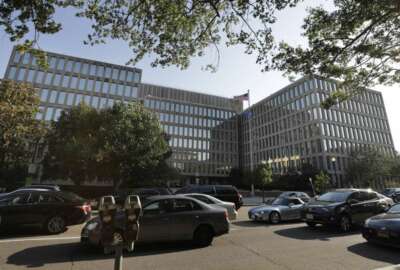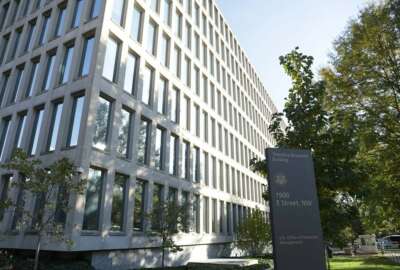Hubbard Radio Washington DC, LLC. All rights reserved. This website is not intended for users located within the European Economic Area.
Data Dive
OPM vows to improve PMF program amid ‘unacceptable decline’ in diverse candidates
Data shows the Presidential Management Fellows program is struggling to attract a diverse pool of candidates and select finalists that are representative of the...
The Office of Personnel Management is taking “immediate steps” to review and make the federal government’s flagship leadership development curriculum more inclusive, citing “pain and frustration” from current and former participants in the Presidential Management Fellows program.
Federal agencies have long tried to recruit and retain a workforce that’s representative of the American population, and the PMF program, designed to attract young, highly-motivated problem solvers to public service, is no exception.
But data shows the PMF program has — at least within the last five years — struggled to attract a diverse pool of candidates and select finalists that are representative of the broader federal workforce, let alone the rest of the country.
The PMF program, which OPM manages, has been through several iterations since its creation back in 1977. Now, more changes are coming.
“Recently, thanks in part to efforts by numerous current and former PMFs to elevate issues of concern, it has become clear to OPM that the agency has been falling short of our standards in several ways,” the agency said in a recent email to the PMF community, which Federal News Network obtained. “Specifically, OPM has failed to address a significant and unacceptable decline in PMF finalists from certain demographic groups and has, at times, failed to foster a fully inclusive environment within the program.”
The June 11 email came from Peter Bonner, OPM’s associate director for Human Resources Solutions, and Mini Timmaraju, a senior adviser to the director. OPM declined to comment on the contents of the email.
Bonner and Timmaraju went on to detail several ways OPM intended to address concerns with the program, starting with the application and assessment process for the upcoming class of 2022 PMF candidates. The PMF program office will review all elements of the fellowship, they said.
“We have made some changes already and are working on others,” OPM wrote.
The agency will, for example, expand its relationships with minority-serving institutions and will tap into its network of PMF alumni to recruit more diverse applicants.
It will also revise the process for assessing candidates and will reexamine how it selects PMF finalists, OPM said.
“For future cohorts we will conduct a new, comprehensive analysis of the skills and competencies needed for the PMF program, out of which will come the design of a new assessment strategy to align with that analysis,” the agency said. “We will also enlist support from experts in diversity, equity, inclusion and accessibility in this process.”
OPM has also asked its inspector general to review the development and implementation of the PMF assessment, a source familiar with the program said.
According to OPM data, 5.7% of 2021 PMF finalists identify as Hispanic, though Hispanics made up 10.5% of the program’s applicant pool.
About 83.4% of the current PMF class is white, but white candidates made up 65.9% of the 2021 applicant pool.
Interested Black or African American candidates made up nearly 18% of the applicant pool, but just 2.9% of 2021 PMF class.
(Use the arrows to see data broken out by gender, ethnicity and race for PMF applicants and finalists between 2016-2021)
Applicants and final selections among Asian PMF candidates are better, according to OPM data. Asians made up 12.6% of the 2021 applicant pool and 12.2% of finalists.
Gender diversity is slightly better within the program, but disparities still exist. Men made up 39.4% of the 2021 applicant pool and 48.3% of PMF finalists.
Women made up 58.8% of this year’s PMF applicant pool and represent 49.7% of today’s finalists, according to recent data.
When it comes to recruiting and selecting Black candidates to the PMF program, data shows the problem has gotten worse over recent years.
Black applicants made up 2.7% of the 2020 PMF class, 4.8% of 2019 finalists, 4.9% of the 2018 class and 3.8% of the 2017 finalists.
In 2016, Black finalists made up 15.9% of the PMF class and 18.7% of applicants. Data from 2016, however, includes information from individuals who started an application with the program and didn’t finish it. OPM began collecting individualized race and ethnicity data in 2017, and some applicants and finalists choose not to disclose that information.
The Biden administration has made it a priority to improve diversity and inclusion within the federal workforce, and multiple agencies have hired new leaders and initiated equity reviews. OPM itself has rebranded and elevated its diversity and inclusion office.
But if the PMF program serves as a pipeline to public service and potentially the Senior Executive Service, the fellowship is falling behind.
According to OPM data, 2.9% of the current PMF class is Black or African American, compared to 18% of the overall federal workforce and 10.5% of the Senior Executive Service.
Hispanics or Latinos make up 5.7% of the 2021 PMF class, but 9.4% of the federal workforce and 4.9% of the SES.
About 83.4% of the current PMF class is white, compared to 61.4% of the overall federal workforce and 77% of the SES.
“We understand the responsibility we have to the public, including the PMF community, in living up to our identity as a premier federal leadership development experience that best utilizes all the tools at our disposal to attract the best talent to the federal workforce, including through the recruitment, hiring, and training of Presidential Management Fellows,” OPM wrote in the email.
OPM to overhaul training, diversify PMF instructors
The PMF program is open to graduate students who have or will complete their advanced degree by a certain date, a requirement alone that can limit the applicant pool to certain populations.
OPM selects between 300-to-600 applicants as finalists each year, depending on agency demand. Finalists go on to apply for temporary appointments at participating agencies under a two-year fellowship.
About 85-to-90% of fellows go on to permanent positions in government for at least a few years, OPM has said. About 10% of the current members of the Senior Executive Service are past fellows, a point of pride for PMF alumni.
OPM has made several changes to the PMF program over the years, including some that were designed to make the application process more inclusive and accommodating to candidates from diverse backgrounds.
Candidates today complete an application and assessment online. Previously, applicants had to physically travel to a testing facility to complete their assessments, which are designed to measure a candidate’s problem solving, communication, interpersonal skills and public service aptitude, among other skills.
Beyond changes to the recruitment, application and assessment process, OPM will revisit and revise its training curriculum for fellows. A more diverse group of federal executives will serve as PMF instructors, and OPM will draw on a more varied group of diversity and inclusion, accessibility, training and talent management experts to find shortcomings and provide feedback on the PMF program.
OPM will also host listening sessions with current fellows and alumni starting next week, the agency said.
“We know there is pain and frustration among PMF stakeholders, most particularly among some current fellows and alumni,” OPM wrote. “We know how valuable your experiences are and want to better leverage your expertise, feedback and suggestions to improve the program.”
When it comes to issues of diversity and inclusion, the Presidential Management Alumni Association, which represents former PMF fellows, said it sees a “willing and invested partner” in OPM.
“We’re encouraged to see OPM leadership taking efforts on diversity, inclusion, equity and accessibility seriously, especially for the government’s flagship leadership development and recruitment program,” Maria DeFazio, PMAA’s executive director, said in a statement to Federal News Network. “We look forward to our community participating in thoughtful conversations about how to make improvements to a program that plays a crucial role in government hiring and development.”
Copyright © 2024 Federal News Network. All rights reserved. This website is not intended for users located within the European Economic Area.
Nicole Ogrysko
Nicole Ogrysko is a reporter for Federal News Network focusing on the federal workforce and federal pay and benefits.
Follow @nogryskoWFED





